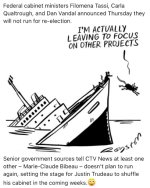The public service has unquestionably
ballooned under Prime Minister Justin Trudeau. Official
figures put the current federal workforce at almost 388,000, up from 257,000 when the Liberals took office. That’s 111,000 more people on the public payroll, a jump of 40 per cent. Canada’s
population has grown just 15 per cent over the same period. Only Trudeau’s father, as prime minister 40 years ago, employed more bureaucrats per Canadian.
Costs have
grown in tandem. While the Canadian Union of Public Employees disputes
reports that public servants earn
more on average than private-sector workers, benefits for government workers far outpace others.
Three times as many are covered by pensions than in the private sector; and while all but a few public pensions offer defined benefits, only a third of private pensions do. While generous pensions are a fading memory for most Canadians, Treasury Board President Anita Anand
agreed this year to expand Ottawa’s plan to an even larger pool of civil servants.
Anyway….
There’s a wondrous circularity to the demand of federal public servants to work from the comfort of their homes rather than trudging into the offices around Ottawa that were built to house them.
Here’s the circle: COVID-19 came along and put huge demands on their services. The Trudeau government responded by hiring enormous numbers of new employees who were able, due to pandemic restrictions, to temporarily work from home. Now the virus is under control but the swollen numbers remain, and they don’t want to return to the office because, they claim, there’s not enough room available to accommodate them all.
Innocent observers might think that, with the emergency over, Ottawa no longer needs all those extra bodies it hired. Let the numbers decline back to pre-COVID levels and voila, problem solved. But innocent observers have obviously never run a union, or a government department, where the idea of reduced membership is about as popular as a case of shingles.
It’s a fundamental tenet of collective bargaining that a job, once created, never ceases to be necessary. So the current position of federal labour leaders is that demanding employees return to the office is both mischievous and cruel, and that working from home should henceforth be the rule rather than the exception.
So…
Public employees retire earlier, take more time off and are much harder to dismiss. While employee numbers in Ottawa have exploded, some of Canada’s biggest companies have been slashing staff to cope with financial pressures: more
than 6,000 at
BCE; 3,000
at TD Bank; an
estimated 800 at Corus Entertainment; 650 at Enbridge; plus hundreds
more at Canada Goose, Hudson’s Bay Co., Indigo Books & Music, Laurentian Bank and others. Even the CBC said it would cut 800 jobs despite its annual $1.3-billion public subsidy, until the Trudeau government
kicked in an extra $96 million.
The federal payroll has been growing even as Canadian productivity
declines. While careful not to place the blame on burgeoning government costs, Anand has
announced — nine years into her government’s mandate — both a task force and a federal study into everything from the size and productivity of Ottawa’s workforce, to its use of technology.
In spite of their favoured position, federal employees have spent months campaigning against efforts to get them back into the office. The Public Service Alliance of Canada (PSAC), which represents 240,000 workers, went to
court to challenge a directive requiring them to spend at least three days a week, instead of two, in the office. The Canadian Association of Professional Employees (CAPE), with 27,000 members, is
demanding a parliamentary committee conduct a hearing into the order.
According to union leaders, federal workers are upset at just about
everything to do with government employment if it involves a desk and chair outside the home. There’s not enough space, offices can be noisy, morale is low, commuting is upsetting, parking is difficult and expensive, and higher-ups don’t know what they’re doing.
CAPE president Nathan Prier
said members have lost confidence in senior management and its “poorly designed, poorly implemented workplace policies.” The Canadian Radio-television and Telecommunications Commission earned a
blast from PSAC president Sharon DeSousa when it offered assigned office seating as a prize in a charity fundraiser. Union leaders
vowed “a summer of discontent” when they first learned of the back-to-office order and have hardly quit complaining about Ottawa’s “anti-worker” attitude ever since.
Apart from the sense of wonderment it inspires, there’s a distinct feel of disconnect about the bureaucrats’ tirade. Their ultimate bosses, the federal Liberals, are under siege. Their popularity is in the tank, there are rumblings of a caucus revolt, cabinet ministers are quitting in bunches and the prime minister can’t go a day without being asked if he’s ever going to leave.
MPs’ own jobs are hanging by a thread and there could be an election soon, which could lead to a new government with a new prime minister whose message is all about controlling costs, downsizing government and getting “more for less.”
You’d think people who work for the government would be aware of these things. Maybe they need to spend more time in the office.
Coddled bureaucrats don't seem to know how good they have it

apple.news
Then, on top of a 40% increase in staffing due to COVID that’s been over for years now…the 40% increase in staffing remained, & earlier this year, the Toronto Sun reported that while Canadians struggle with the ongoing cost-of-living crisis,
public servants and employees of government agencies earned hundreds of millions of dollars in overtime????
Canada currently employs 9,155 public servants in the executive categories

apple.news
“Taxpayers are paying through the nose because everywhere you look the size and cost of government is ballooning,” said Terrazzano.
“If any politician is serious about fixing the budget and cutting taxes, they will have to shrink Ottawa’s bloated bureaucracy.” You’d think (again) that these people complaining about having to go to the office three times a week years after Covid has ended….With the temporary “work from home during Covid thing” for social distancing years in the past now…(?)…that they would at least have a finger on the pulse of the rest of the nation?






